Facts about human blood

Human body is basically functioning very well with the cooperation of all internal and external organs. So many parts present in the body also helps to keep the body healthy. Several tissues and cells are contributing their activities to keep the body healthy. In this article, we will see in depth about the human blood. This article will clearly explain some amazing facts about the blood.
What is blood?
One of the most essential for humans to live a life is blood. Human Blood travels from top to bottom of the body and supplies essential substances like oxygen and nutrients to the body’s cells. This specialized body fluid has four main components such as
- Plasma.
- Red Blood Cells.
- White Blood Cells.
- Platelets.
Blood has so many functions, such as transporting oxygen and nutrients to the lungs and tissues.
Human Blood types
Blood has different types, but the most common blood type is 8. They are
- A+
- A-
- B+
- B-
- O+
- O-
- AB+
- AB-
Some blood types are the rarest group. They are
- AB- (AB negative) – This blood type, which is seen in just 0.6 percent of people in the United States.
- B- (B negative) – This blood type is only found in 1.5 percent of the United States population.
- AB+ (AB positive) – This blood type is only present in just 3.4 percent of people in the United States.
Golden Blood
In this world one of the rarest blood types is Rh-null. Around the world, less than 50 people have this blood type, that’s why this type of blood is called “Golden blood”.
Amazing facts about Human Blood
- Blood Color: Human beings have blood in the color of Red. All living things in this world have the same blood color, some living things have blood in the color of blue, violet, yellow and green. The color of blood is based on the type of respiratory pigment used to transport oxygen via the circulatory system to cells. The respiratory pigment in the human body is a protein called hemoglobin found in red blood cells.
- Blood In Human body: A young person has approximately 65-70 ml of blood per kg of body weight. Blood makes 7 to 8 percent of weight in the total body weight. Commonly humans have around 5 liters of blood in their bodies. A young man’s volume of blood is approximately 5.5 liters and young women 4.5 liters of blood.
- Blood Cells: There are so many numbers of cells present in the blood. One ounce of blood contains 150 billion red blood cells. Around 2.4 Trillion red blood cells present in one pint of blood. Every second 17 million red blood cells are produced by the human body. During the high stress time the body can produce up to 7 times that amount.
- LifeTime: The blood cells also have a lifetime. Red blood cells have a lifetime of 120 days, White blood cells have a lifetime from a few hours to 12 days. The size of White blood cells is larger than red blood cells. The platelets present in the blood have a lifetime for about 9 days. The plasma cell’s lifetime is 3-5 days to several months. Short lived plasma cell lifespan is 5 days and long lived plasma cell lifespan is several months to lifetime.
Blood recipients
Human body blood type allows providers to determine which blood types are safe for them to receive. It helps them know which recipients can safely receive blood from donors.
- A positive: People who have A positive blood type can receive blood that’s A positive, A negative, O positive or O negative.
- A negative: People who have A Negative blood type can receive blood that’s A negative or O negative.
- B positive: People who have B positive blood type can receive blood that’s B positive, B negative, O positive or O negative.
- B negative: People who have B negative blood type can receive blood that’s B negative or O negative.
- AB positive: People who have AB positive blood type can receive any blood type. This is called a Universal recipient.
- AB negative: People who have AB negative blood type can receive blood that’s AB negative, A negative, B negative or O negative.
- O positive: People who have O positive blood type can receive blood that’s O positive or O negative.
- O negative: People who have O negative blood type can only receive blood that’s O negative.
Some other interesting facts about Blood
- A normal person’s body has over 160,000 km of blood vessels, which if laid end to end, would stretch 2 and a half times around the Earth.
- In a person’s average lifetime the organ heart pumps 1.5 million barrels of blood. This amount of blood can be enough to fill 200 train tank cars.
- Pregnant women have roughly 50% more blood than a normal woman.
- One blood cell is able to make a complete circuit of the whole body in less than 30 seconds.
- A new born body contains one cup of blood.
- The insect mosquitoes mostly prefer the people with blood type “O”
- When a person sees the strange bright white dots floating around him/her while looking at the sky are white blood cells; it is called the blue field entoptic phenomenon.
Blood is an important thing to live a healthy life, so people should keep their blood level well and good in order to have optimal body health. Doing a regular body check up will help to know the health of blood. People should know their blood type, this will help to start a treatment during an emergency situation. People who don’t know about their blood type, they should doctor help, or else use home blood test kits to determine their blood type.

